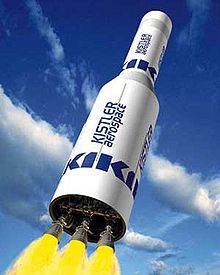 A render of the K-1 in flight, produced by Rocketplane Kistler | |
| Function | Orbital launch vehicle |
|---|---|
| Manufacturer | Kistler Aerospace |
| Country of origin | United States |
| Size | |
| Height | 36.9 m (121 ft) |
| Diameter | 6.7 m (21.9 ft) |
| Stages | 2 |
| Capacity | |
| Payload to Low Earth orbit | |
| Altitude | 200 km (120 mi) |
| Orbital inclination | 45° |
| Mass | 4,500 kg (9,900 lb)[1] |
| Payload to International Space Station | |
| Mass | 3,200 kg (7,100 lb)[2] |
| Payload to Geostationary transfer orbit | |
| Altitude | 900 km (560 mi) |
| Orbital inclination | 60° |
| Mass | 1,570 kg (3,460 lb)[2] |
| Associated rockets | |
| Comparable | |
| First stage – Launch Assist Platform | |
| Height | 18.4 m (60 ft)[1] |
| Diameter | 6.7 m (22 ft)[1] |
| Empty mass | 20,500 kg (45,200 lb)[1][note 1] |
| Gross mass | 250,000 kg (550,000 lb)[1][note 1] |
| Powered by | 3 × NK-33 |
| Maximum thrust | 4,530 kN (1,020,000 lbf) sea level[1] |
| Specific impulse | 297 seconds sea level |
| Burn time | 168 seconds (plus additional 35 seconds for boostback burn)[1] |
| Propellant | RP-1 / LOX |
| Second stage | |
| Height | 18.6 m (61 ft)[1] |
| Diameter | 4.27 m (14.0 ft)[1] |
| Empty mass | 13,100 kg (28,900 lb)[1][note 2] |
| Gross mass | 131,000 kg (289,000 lb)[1][note 2] |
| Powered by | 1 × NK-34 |
| Maximum thrust | 1,769 kN (398,000 lbf) vacuum |
| Specific impulse | 348 seconds vacuum |
| Burn time | 233 seconds[1] |
| Propellant | RP-1 / LOX |

The Kistler K-1 was a two-stage, fully reusable launch vehicle design created by Kistler Aerospace. It was to accommodate a wide range of missions, including payload delivery to low Earth orbit (LEO), payload delivery to high-energy orbits with a K-1 Active Dispenser, technology demonstration flights, microgravity missions, and commercial cargo resupply, recovery, and reboost services for the International Space Station (ISS).
In 2004, the company won a NASA contract to fly supply missions to ISS. At the time, Kistler claimed that the design of the K-1 was 75% complete, and the $227 million NASA contract would be used to complete development and the first flights. SpaceX protested, suggesting that the presence of well-known former NASA engineers biased the decision in favor of Kistler. The Government Accountability Office (GAO) sided with SpaceX and NASA suspended the contract in favor of a new process, the Commercial Orbital Transportation Services (COTS) program.
Lacking funding to complete development, in 2006 Kistler was purchased by Rocketplane Limited, Inc, who had previously been developing a competing concept. Both SpaceX and the new Rocketplane Kistler won COTS contracts in August 2006, but after failing to meet several financial milestones, NASA announced in October 2007 that it was terminating funding for the project.[3] The company declared bankruptcy in 2010.
- ^ a b c d e f g h i j k l Cite error: The named reference
Ast-K1was invoked but never defined (see the help page). - ^ a b Cite error: The named reference
k1-leporewas invoked but never defined (see the help page). - ^ Berger, Brian (2007-09-07). "NASA Gives Rocketplane Kistler Termination Notice". Space.com.
Cite error: There are <ref group=note> tags on this page, but the references will not show without a {{reflist|group=note}} template (see the help page).